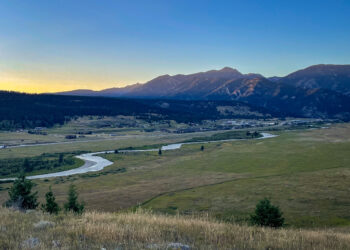Logging doesn’t reduce fire risk if it doesn’t address surface fuels
By Benjamin Alva Polley EBS COLUMNIST
Recently, President Trump issued an executive order instructing federal land managers to increase logging and engage in more aggressive forest management. Some politicians argue that it is necessary to prevent major wildfires, especially in the Interior West’s fire-prone, seasonally dry forests. While it is true that wildfires have become more severe and our forests are overgrown and dense, this is only part of the solution.
To gain a deeper understanding, I consulted an expert: Andrew Larson, a professor of forest ecology and director of the Wilderness Institute at the University of Montana.
“Logging alone doesn’t address the ignition sources,” he explained. “We know how to manage fuels and forests to reduce fire risks and to engage more safely with fires from a suppression perspective.”
Larson suggests that forest managers should focus on four key areas. First, they should preserve the most fire-resistant trees, particularly larger ones with thick bark and high crowns. Second, it’s essential to increase the spacing between trees. By doing this, if one tree catches fire, it is less likely to spread to others and ignite a crown fire that runs through the forest. These first two recommendations promote lower-density forests, which can be achieved through mechanical logging.
The other two vital factors in managing forests involve reducing fire risk by decreasing ladder fuels—the smaller trees that can carry fire from the ground to the forest canopy—and reducing surface fuels—the logs, dead branches, leaves, low vegetation and other organic matter on the forest floor. Unfortunately, these smaller trees and surface fuels are not commercially viable and cannot be utilized to produce wood products, which is an incentive for the current administration’s push for logging as a means of forest management.
“To effectively reduce fire risk and manage fuels, we must address ladder fuels, which can be costly for the industry,” Larson noted. “… If you don’t treat the surface fuels, you won’t have any meaningful impact on reducing fire risk.”
Harvesting a forest can contribute to surface fuels because many small trees and branches are left on the forest floor, accumulating fuel and adding to the fire if there is an ignition point. Larson emphasized the importance of using prescribed fire to carefully burn through surface fuels, whereas tree removal alone may actually worsen the situation.
“The most effective approach is to combine mechanical harvesting with prescribed fire; they should be closely linked,” he said. “… When you combine mechanical treatments with prescribed fire, you influence the subsequent fire behavior and severity. Mechanical harvest is important, but it will not solve the problem alone.”
So, how did the forests become so overgrown?
When Euro-American colonization began across the West, Native Americans were displaced and their use of fire was halted. Historically, much of the landscape was managed with fire. Native Americans contributed to the natural fire regime, along with lightning-induced fires across hundreds of millions of acres in the West.
With the removal of Indigenous groups, we eliminated a key ignition source. Additionally, we implemented a highly effective policy of suppressing natural ignitions, which worked for a while but ultimately led to an accumulation of fuels in the forest for over a century and a half. Our scientific understanding of forestry was primarily grounded in agriculture and economics. Foresters were trained at the Yale School of Forestry on the East Coast, where they did not have a significant focus on fire and did not fully understand how forests in the West evolved around fire.
It wasn’t until Harold Weaver in the 1940s and ‘50s that the understanding of ecology and the role of fire in different forest types began to emerge. Mainstream scientific research did not gain momentum until the ‘70s, and it wasn’t until the ‘80s and ‘90s that forest managers recognized the need to change their approach in fire-prone areas.
“Now we’re a century behind,” Larson said. “Climate change is accelerating these past effects, making them more severe and intense. It’s the combination of the vast accumulated fuel and hotter, drier environments that climate change is pressing upon the landscape.”
Now more than ever, we must marry mechanical harvesting with prescribed burns to prevent major fires.
Benjamin Alva Polley is a place-based storyteller. His words have been published in Audubon, Esquire, Field & Stream, The Guardian, Men’s Journal, Outside, Popular Science, Sierra, and other publications, and they are on his website.














